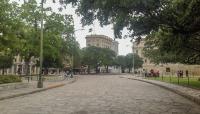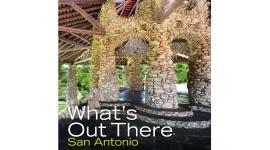Landscape Information
Established as a Spanish mission in 1724, the Alamo has also served as a U.S. government Quartermaster’s department, a hospital, and, today, a museum and archaeological site. A stone church with twin symmetrical towers, a barrel vault, and a dome was built in 1744 (but was largely destroyed in the late 1750s), and the site soon expanded to include shops, dwellings, and storehouses built of adobe. All that remains of the original site is the chapel (with its non-historic curvilinear gable in place of the original bell towers); the restored ruins of the long barracks; and a wall that runs parallel to East Houston Street before turning 90 degrees toward the chapel.
The western Alamo Plaza, a linear, north-south grand boulevard, is anchored by the 1939 Alamo Cenotaph to the north and the 1976 gazebo to the south. The flagstone-paved plaza acts as an island that buffers vehicular traffic from the Alamo. It comprises a series of two-foot-high, raised terraces filled with ryegrass. The terraces are lined with live oaks that provide shade.
Enclosing the church to the north and east, the Convento Courtyard is radially designed with concrete walking paths set amid strips of Bermuda, zoysia, ryegrass and flowerbeds with plantings of yucca, agave, cacti, wildflowers, redbuds, Texas mountain laurels, papaya, peach, and pecan. It also contains live oaks, including the 148-year-old Big Tree, brought to the site in 1912 by Walter Whall and planted behind the north barracks wall. The Alamo was listed in the National Register of Historic Places in 1966 and was designated a National Historic Landmark in 1960.




















